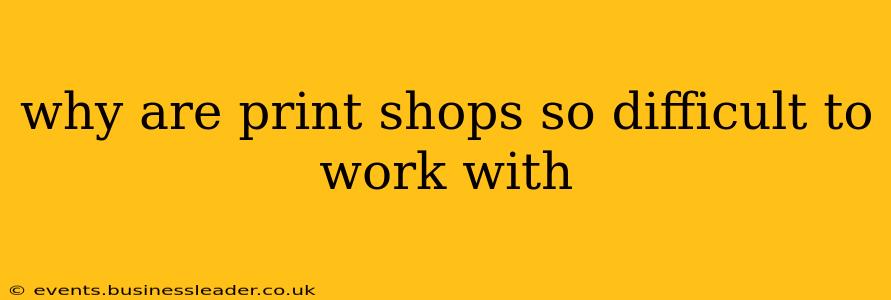Many people find working with print shops challenging. The process can be fraught with potential pitfalls, from miscommunication about design specifications to unexpected delays and cost overruns. This article explores the common frustrations associated with print shop collaborations and offers strategies for a smoother experience.
Why is it so hard to get my print job right?
This is a central frustration for many clients. The problem often stems from a disconnect between the client's vision and the print shop's capabilities or understanding. Clear communication is paramount. Ambiguous instructions, insufficiently detailed design files (low resolution images, incorrect color profiles, etc.), and a lack of pre-press proofing all contribute to inaccurate final products. The print shop may not always possess the expertise to interpret vague requests or identify potential issues within the submitted files.
What are common problems when working with print shops?
Several common issues plague the print production process:
- Miscommunication: This is the biggest culprit. Clients may not clearly articulate their needs, while print shops may not actively clarify ambiguous requests or explain technical limitations.
- File Preparation: Incorrect file formats, inadequate resolution, and inappropriate color profiles are common reasons for print errors. Print shops often have specific file preparation guidelines that clients overlook.
- Proofing: Insufficient or absent proofing is a significant risk. Reviewing a proof before the full print run is crucial for identifying errors early and avoiding costly reprints.
- Unrealistic Expectations: Clients may have unrealistic expectations regarding turnaround times or budget constraints. Print shops often have lead times and minimum order quantities that aren't immediately apparent.
- Hidden Costs: Some print shops may not fully disclose all costs upfront, leading to unpleasant surprises later. It's essential to clarify all charges before giving the go-ahead.
- Lack of Customer Service: Poor communication, unresponsive staff, and lack of problem-solving can exacerbate frustrations.
What are the best ways to avoid problems with print shops?
Proactive steps can significantly improve the print shop experience:
- Choose the Right Print Shop: Research and select a print shop with a strong reputation, relevant experience, and positive customer reviews.
- Clear Communication: Provide detailed instructions, clear specifications, and high-resolution design files. Ask clarifying questions and ensure everything is understood.
- Thorough Proofing: Always review and approve proofs carefully before giving the final go-ahead.
- Realistic Expectations: Set realistic deadlines and budgets. Allow ample time for the print process, and factor in potential delays.
- Detailed Quote: Request a detailed quote that outlines all costs, including setup fees, printing costs, finishing, and shipping.
- Open Communication: Maintain open communication throughout the process. Don't hesitate to ask questions or raise concerns.
How do I find a good print shop?
Finding a reliable print shop involves due diligence:
- Online Reviews: Check online reviews on platforms like Google, Yelp, and industry-specific websites.
- Recommendations: Seek recommendations from other businesses or professionals.
- Portfolio Review: Examine the print shop's portfolio to assess the quality of their work.
- In-Person Visit: If possible, visit the print shop to see their facilities and speak with the staff directly.
- Request Samples: Ask for samples of their work to evaluate the quality of their printing and materials.
Why are print shops so expensive?
The cost of print jobs depends on several factors:
- Material Costs: The type of paper, ink, and other materials used significantly impacts the price.
- Printing Method: Different printing methods (offset, digital, screen printing) have varying costs.
- Quantity: Larger quantities often result in lower per-unit costs.
- Finishing Options: Finishing options like binding, lamination, and die-cutting add to the expense.
- Setup Costs: There are often setup costs associated with preparing the printing plates or digital files.
By understanding the common challenges and implementing these strategies, you can navigate the complexities of working with print shops more effectively and achieve better results. Remember, clear communication, thorough preparation, and realistic expectations are key to a successful collaboration.
